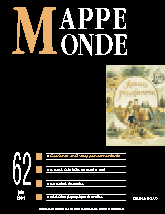
Charlotte Michel, Sylvie Lardon. Access to natural areas: the contribution of choremes to managing conflicts of use (4 fig.)
Natural, agricultural and forest areas are places where all sorts of users meet. Access to these areas is jeopardised when conflicts of use increase between these various users. Examining these conflicts in a municipality of Puy-de-Dôme (central France) highlights the spatial configurations conducive to their emergence: proximity between a house and a walking trail, a walking trail that crosses summer pastures, etc. The «spatial grammar» of choremes can be used to define typical situations and imagine solutions.
keywords: ACCESS, CHOREME, CONFLICTS OF USE, LEISURE, PROPERTY, TERRITORY
Farm territories and village territories: changing patterns in Lorraine (2 fig.)
The traditional association between farm territories and village territories in Lorraine has changed significantly. Chorematic analysis can be used to chart and understand this changing pattern, by highlighting farming trends and the transformation of spatial organisation.
keywords: LORRAINE, POLYCULTURE-LIVESTOCK, SPATIAL ORGANISATION
Muriel Bonin. New functions of agriculture and farm dynamics: a chorematic analysis in the Monts d'Ardèche (4 fig.)
Spatial models are used to analyse farm dynamics in the Regional Natural Park of Les Monts d'Ardèche. They highlight the links between social and economic transformations and farm territories. The main patterns of spatial dynamics are identified and used to evaluate the impact of agritourism on farm territories.
keywords: AGRITOURISM, FARM TERRITORY STRUCTURES AND DYNAMICS, NEW FUNCTIONS OF AGRICULTURE
Graphic modelling and choremes: management of common rights in Massaroca (Nordeste, Brazil) (4 fig.)
With a view to analysing livestock breeders' practices, trends in the appropriation and use of common land and forage resources in the Massaroca region were modelled graphically by using choremes. This modelling provided researchers with an appropriate medium for stimulating a co-ordination process between local stakeholders and the definition of new rules for managing the commons, made necessary by an enclosure process.
keywords: BRASIL, CHOREME, THE COMMONS, DECISION, MANAGEMENT, MODELLING, NORDESTE
Clarisse Didelon. The modernisation of India's railways: between integration and exacerbation of regional disparities (2 fig.)
The Indian railway network is being renovated. The intended purpose of this work is to foster the integration of underdeveloped states into the national space. However, an examination of the changes to the network in north-western India shows that it could in fact exacerbate regional disparities.
keywords: INDIA, NETWORK, RAILWAY, REGIONAL DISPARITY
Marie-Caroline Saglio. Mumbai: spatial changes in an expanding metropolis (3 fig.)
Mumbai (Bombay), a booming international capital whose urban growth is confined to a peninsula, needs to redevelop its municipal and regional territory. Proposals include the creation of a new business centre in Mumbai, development of the new town of Navi Mumbai and of the periphery.
keywords: BUSINESS DISTRICT, INDUSTRIAL RELOCATION, NEW TOWN, SHANTY TOWN, URBAN DEVELOPMENT
Delhi: population and spatial trends of a large metropolis (6 fig.)
Despite a decline in recent decades, population growth in Delhi since 1947 is remarkable for a city of this size. This overall growth covers a tendency towards a loosening of the population, with depopulation of the old historic centre and accelerated growth of peripheral areas. This growth spills over the administrative boundaries of the territory of Delhi. Migration, mainly from neighbouring states, has played a major part.
keywords: DELHI, METROPOLISATION, PERIURBANISATION, RURAL-URBAN MIGRATION, URBAN GROWTH
Port Louis, Mauritius: a harbour and a capital (4 fig.)
The development of Port Louis, the capital of Mauritius, has been spurred alternately by the harbour and by autonomous operation driven by other forces. This article proposes an overview of the relationships between the town and the harbour, with a view to understanding urban dynamics and clarifying the relationships that underpin Mauritius's economic success and that have made the capital a harbour town.
keywords: CBD, FREEPORT, HARBOUR, MAURITIUS, OFFSHORE SERVICE, TOWN
19th century geographical alphabet primers: pretext geography (5 fig.)
Only a few specialists are aware of the existence of the short-lived geographical alphabet primers of the 19th century. They were intended for children to practice reading letters and syllables. Geography was relegated to the role of pretext for learning how to read. These books were a sign of their times, however, and it is worth rescuing them from oblivion.
keywords: 19th CENTURY, ALPHABET PRIMER, EARLY CHILDHOOD, GEOGRAPHY, READING
Book reviews (Gilles Fumey, Jean-Christophe Gay)
Mappemonde 1/01![]()
![]() Mappemonde 3/01
Mappemonde 3/01
For subscribe or buy this issue: BELIN
Last modified: May 28, 2001